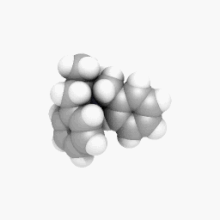Benzphetamine
 | |
 | |
| Clinical data | |
|---|---|
| Trade names | Didrex, Recede |
| Other names | N-benzyl-N-methylamphetamine |
| AHFS/Drugs.com | Professional Drug Facts |
| License data | |
| Dependence liability | High[1] |
| Routes of administration | By mouth |
| ATC code |
|
| Legal status | |
| Legal status |
|
| Pharmacokinetic data | |
| Protein binding | 75–99% |
| Elimination half-life | 4-6 hours |
| Identifiers | |
| |
JSmol) | |
| |
| |
| | |
Benzphetamine (brand name Didrex) is a
Benzphetamine is an anorectic, primarily promoting weight loss through reduced appetite. It also slightly increases metabolism.
Pharmacology
Benzphetamine is a
Although the mechanism of action of the sympathomimetic appetite suppressants in the treatment of obesity is not fully known, these medications have pharmacological effects similar to those of amphetamines.
Benzphetamine has a
Contraindications
Benzphetamine is contraindicated in patients with advanced arteriosclerosis, symptomatic cardiovascular disease, moderate to severe hypertension, hyper-thyroidism, known hypersensitivity or idiosyncrasy to sympathomimetic amines, and glaucoma, or who have recently used a MAOI. Benzphetamine should not be given to patients who are in an agitated state or who have a history of drug abuse.[8]
Controlled substance classification
Benzphetamine is unique in its classification as a Schedule III drug in the United States. (Most members of the amphetamine family are classified in the more highly regulated Schedule II.) Benzphetamine is metabolized by the human body into amphetamine and methamphetamine, making it one of a number of drugs to undergo in vivo conversion to a substance of higher addiction and abuse potential.[9]
References
- ^ "Benzphetamine". Toxnet. Archived from the original on 2018-11-01.
- ^ Anvisa (2023-07-24). "RDC Nº 804 - Listas de Substâncias Entorpecentes, Psicotrópicas, Precursoras e Outras sob Controle Especial" [Collegiate Board Resolution No. 804 - Lists of Narcotic, Psychotropic, Precursor, and Other Substances under Special Control] (in Brazilian Portuguese). Diário Oficial da União (published 2023-07-25). Archived from the original on 2023-08-27. Retrieved 2023-08-27.
- ISBN 978-1-934863-59-6.
- PMID 9681333.
- .
- PMID 10774541.
- ISBN 978-0-8036-3827-3.
- ^ "Benzphetamine". Toxnet. Archived from the original on 2018-11-01.
- S2CID 20012024.
External links
- "Benzphetamine". Drug Information Portal. U.S. National Library of Medicine.
- "Benzphetamine hydrochloride". Drug Information Portal. U.S. National Library of Medicine.
